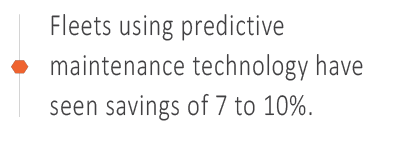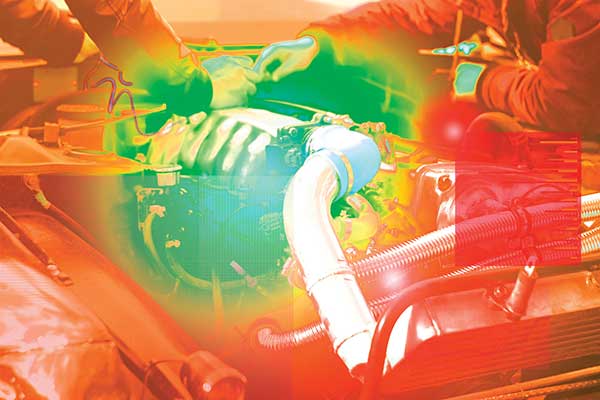Vehicle Maintenance is without any doubt a critical focus for every fleet manager. In most cases vehicle maintenance is right behind fuel in being the highest cost for a service operation. In years past, ensuring a vehicle’s oil was changed or tires were rotated within the proper interval was about all a fleet manager could do until a “check engine” light appeared.
In today’s world, telematics provide the fleet manager with the ability to discover serious engine issues prior to the vehicle even showing an engine light thus reducing the likelihood of an expensive repair. The truth is, the engine repair is only part of the “true” cost to a business as taking a vehicle out of service for a lengthy repair can require significant resources and cost much more than the actual repair.
PREDICTIVE MAINTENANCE
Early detection is obviously the key when it comes to maintenance. Predictive maintenance involves analyzing data and predicting major, medium, and minor issues two to four weeks or more before they even arise. This early detection can save companies a huge amount of money, both in repair costs as well as downtime for the vehicle when it should be on the road.
Rather than waiting for something to actually break or continue to degrade—which will have even higher repair costs—fleet managers can “nip it in the bud.” By incorporating predictive insights into maintenance strategies, managers can take preemptive steps to predict issues earlier than ever, which ultimately reduces downtime and overall maintenance costs by catching a problem before something catastrophic happens.

PREDICTIVE INSIGHTS
There are several good systems that offer predictive and prescriptive maintenance reports for fleets. I recommend you find one that can give you vetted data in real time. This can provide an at-a-glance health status of your entire fleet. A system like this assists fleet managers in detecting serious problems early on, then diagnosing them and prescribing a fix.
The seven major systems that should be monitored are: brakes, coolant, electrical, engine, exhaust, fuel, and transmission. By using a vehicle’s operating history along with analyzing the engine’s key performance indicators, a true preventive maintenance system changes hindsight to foresight to keep fleet vehicles on the road.
Consider a system powered by artificial intelligence (AI). Using vehicle component sensor data and fault codes ingested from a telematics device, information is combined with contextual data and work orders to predict and prevent impending failures. The results are saving on maintenance costs and reducing unplanned downtime. Fleets using this technology have seen savings of 7 to 10% and have enabled maintenance technicians to make the right repair the first time, reducing the total vehicle shop time. That is time where your vehicle is costing more than it is earning.
EFFECTIVE MANAGEMENT
Here’s my bold prediction: The sooner fleet managers adapt and learn this newer technology, the more empowered they’re going to be—long term—for their businesses and within the fleet industry. The fleet managers who resist this change are going to fall way behind exponentially and possibly (probably) jeopardize their position.
With many of these systems becoming automated, artificial intelligence and machine-learning is going to make a fleet manager’s job more important because it will ultimately help reduce costs and help users manage their fleet more effectively.
I know many fleet managers who are overwhelmed, even if they’re only managing one part of the fleet, whether it’s the efficiency of maintenance or safety. They can’t do it all. Now that fleet managers and companies have the tools to be able to automate processes that can be automated, it allows them to focus more on the areas that need the human touch. That’s the overall goal of telematics: to empower the fleet managers and save companies exponential amounts of money when it comes to maintenance. This, as we all know, is undoubtedly one of the top three expenses of their business.
Telematics technologies using AI are going to play a pivotal role in vehicle maintenance during the next five years and beyond, whether a gas-powered or an electric-powered vehicle. The future of fleet management is here. Get to know more about how these telematics solutions can translate new data into actionable information to keep your fleets up and running. It’s the fast lane to success for you and your company, creating a significant ROI for the business and proving the value of a forward-thinking fleet manager.
ABOUT THE AUTHOR
Stuart Lamm is the founder and president of BlueArrow Telematics. He began his company in the early 1990s as an entrepreneur in wireless technologies for the mobile workforce. His vision and understanding of technology led him to focus his company on telematics where his deep knowledge of the industry helps integrate technology for fleets all over the country. Email him at SBL@bluearrowmail.com.
BlueArrow Telematics is a hub of integrative technology products and services that are specialized for fleet vehicles, work trucks, long-haul vehicles, and the needs of the companies using them. The BlueArrow team supports integration of telematics for industries like: construction, field services, transportation, education, emergency management services, municipal, and state governments.




